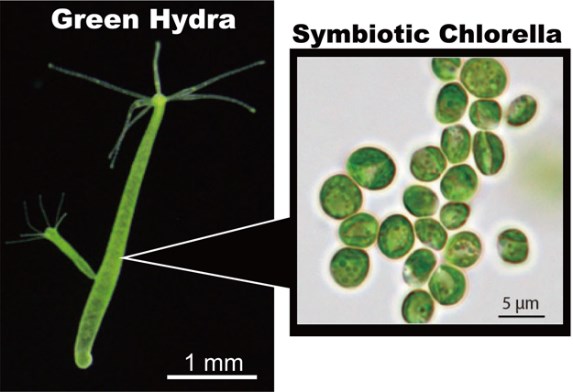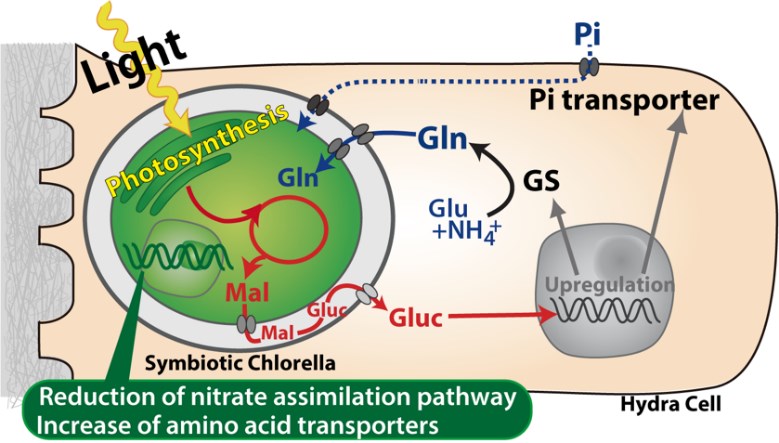Enlarge Image (Figure2)Summary of symbiotic interactions between Hydra and Chlorella. Chlorella produces and secretes maltose (Mal) as the photosynthetic product. The sugar induces expression of Hydra genes encoding glutamine synthetase (GS) and Phosphate (Pi) transporter. GS catalyzes the condensation of glutamate (Glu) and ammonium (NH4+) to form glutamine (Gln), which is used by Chlorella as a nitrogen source. Since the sugar also up-regulates the Pi transporter gene, which controls intracellular phosphate levels, it might be involved in the supply of phosphorus to Chlorella as well (blue broken line). In the symbiotic Chlorella genome, degeneration of the nitrate assimilation system and an increase of amino acid transporters was observed (green balloon).
Enlarge Image
Insights into symbiosis between animals and algae: Genome analysis reveals interactions and evolution of Hydra-Chlorella symbiosis
Symbiotic existence between animals and algae are observed in many species, such as coral and jellyfish, where mutually beneficial relationships are established by exchanging nutrients and providing a safe living environment.
However, details of the interactions of these relationships and the evolutionary processes of symbiosis are still unclear.
Mayuko Hamada, an assistant professor at Ushimado Marine Institute, Okayama University, and a research group led by Noriyuki Satoh, a professor at Okinawa Institute of Science and Technology Graduate University, together with another research group led by Thomas C. G. Bosch of Kiel University, solved the mystery of animal-algal symbiosis using green hydra that harbor green algae Chlorella within their cells (Fig.1).
The researchers identified the important genes involved in symbiosis, genome and transcriptome analysis of green hydra and the symbiotic Chlorella.
The results of the analysis identified a cooperative relationship involving nutrients, in which Chlorella receives some nutrients such as amino acids from Hydra while providing photosynthetic products to Hydra (Fig. 2). In addition, as the number of transporter genes for taking in amino acid supplied by Hydra increased in the symbiotic Chlorella, its nitrate assimilation system degenerated. This clearly shows that the symbiotic Chlorella specialized within the body of Hydra to live efficiently.
This research not only improves the understanding of the evolution of such unique symbiotic relationships, but also it is expected to act as a foundation for solving environmental issues such as coral bleaching and industrial applications of algae.
Reference:
- Authors: Mayuko Hamada, Katja Schröder, Jay Bathia, Ulrich Kürn, Sebastian Fraune, Mariia Khalturina, Konstantin Khalturin, Chuya Shinzato, Nori Satoh, Thomas C.G. Bosch
- Title of original paper: Metabolic co-dependence drives the evolutionarily ancient Hydra-Chlorella symbiosis.
- Journal, volume, pages and year: eLife 7, e35122 (2018).
- Digital Object Identifier (DOI): 10.7554/eLife.35122
- Journal website: https://elifesciences.org/articles/35122
- Affiliations: Ushimado Marine Institute, Okayama University
- Institute website: http://www.science.okayama-u.ac.jp/~rinkai/index.html
- Okayama University Scientific Achievement Repository: http://ousar.lib.okayama-u.ac.jp/56311



